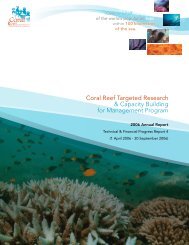Pulse Amplitude Modulation Fluorometry - Coral Reef Targeted ...
Pulse Amplitude Modulation Fluorometry - Coral Reef Targeted ...
Pulse Amplitude Modulation Fluorometry - Coral Reef Targeted ...
Create successful ePaper yourself
Turn your PDF publications into a flip-book with our unique Google optimized e-Paper software.
Figure 2 Percent abundance ofMontastraea cavernosa coloniescontainingendosymbioticcyanobacteria at different depthsaround Lee Stocking Island, Bahamas.Significant differences were observedwith depth using a contingency tableanalysis; Likelihood ratio, χ2 =18.17P=0.006, Pearson, χ2 =14.065P=0.03. Post-hoc multiple comparisontesting showed that the population oforange M. cavernosa were significantlygreater deeper (≥15 m) compared toshallow depths (≤ 12 m).The presence of cyanobacterial symbionts that can fix nitrogen inzooxanthellate corals represents not just a novel microbial consortium ofphotosynthetic eukaryotes and prokaryotes, but one that challenges the longtermparadigm that nitrogen is limiting in corals. Our observations indicate thatseveral species of scleractinian corals in the Caribbean and on the GreatBarrier <strong>Reef</strong> have individuals harboring stable, non-pathogenic populations ofendosymbiotic cyanobacteria. If the occurrence of this consortium in otherspecies of scleractinian corals residing in oligotrophic tropical waters is morecommon than previously believed, it could provide an important supplementalsource of a limiting element for zooxanthellate corals. These inputs of newnitrogen from endosymbiotic cyanobacteria in corals not only has importantimplications for our current understanding of the role of nitrogen as a limitingand regulatory element in these associations, but also requires that we reexaminethe role corals play in the nitrogen budgets of coral reefs. Becausecorals release large quantities of dissolved organic material containing highconcentrations of both organic and inorganic sources of nitrogen the implicationof corals as nitrogen fixes consortiums for the biogeochemical fluxes of nitrogenin carbonate sands and pore waters of coral reefs are potentially very large.22








